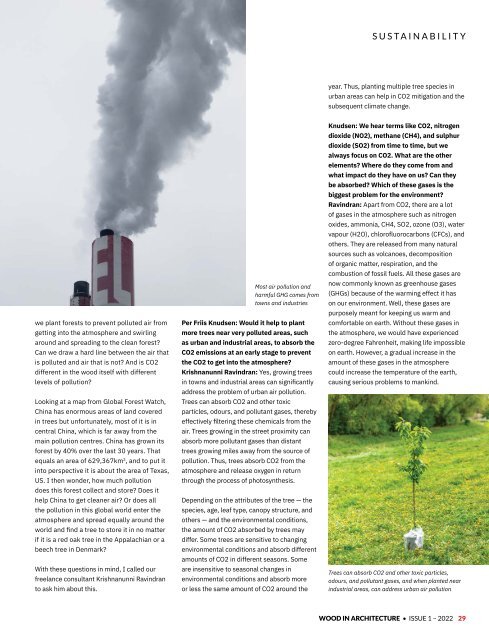Wood In Architecture Issue 1, 2022
First published in 2017, Wood in Architecture (WIA) is a bi-annual trade magazine devoted to the international timber construction sector. The newest addition to the Panels & Furniture Group of wood magazines, WIA features in-depth insights to the latest industry news, incredible projects and leading trade events. WIA is an advocate for timber as a material of choice for today’s built environment, and is the perfect source of inspiration for architects, builders, engineers and interior designers across the globe.
First published in 2017, Wood in Architecture (WIA) is a bi-annual trade magazine devoted to the international timber construction sector. The newest addition to the Panels & Furniture Group of wood magazines, WIA features in-depth insights to the latest industry news, incredible projects and leading trade events. WIA is an advocate for timber as a material of choice for today’s built environment, and is the perfect source of inspiration for architects, builders, engineers and interior designers across the globe.
You also want an ePaper? Increase the reach of your titles
YUMPU automatically turns print PDFs into web optimized ePapers that Google loves.
SUSTAINABILITY<br />
year. Thus, planting multiple tree species in<br />
urban areas can help in CO2 mitigation and the<br />
subsequent climate change.<br />
we plant forests to prevent polluted air from<br />
getting into the atmosphere and swirling<br />
around and spreading to the clean forest?<br />
Can we draw a hard line between the air that<br />
is polluted and air that is not? And is CO2<br />
different in the wood itself with different<br />
levels of pollution?<br />
Looking at a map from Global Forest Watch,<br />
China has enormous areas of land covered<br />
in trees but unfortunately, most of it is in<br />
central China, which is far away from the<br />
main pollution centres. China has grown its<br />
forest by 40% over the last 30 years. That<br />
equals an area of 629,367km 2 , and to put it<br />
into perspective it is about the area of Texas,<br />
US. I then wonder, how much pollution<br />
does this forest collect and store? Does it<br />
help China to get cleaner air? Or does all<br />
the pollution in this global world enter the<br />
atmosphere and spread equally around the<br />
world and find a tree to store it in no matter<br />
if it is a red oak tree in the Appalachian or a<br />
beech tree in Denmark?<br />
With these questions in mind, I called our<br />
freelance consultant Krishnanunni Ravindran<br />
to ask him about this.<br />
Most air pollution and<br />
harmful GHG comes from<br />
towns and industries<br />
Per Friis Knudsen: Would it help to plant<br />
more trees near very polluted areas, such<br />
as urban and industrial areas, to absorb the<br />
CO2 emissions at an early stage to prevent<br />
the CO2 to get into the atmosphere?<br />
Krishnanunni Ravindran: Yes, growing trees<br />
in towns and industrial areas can significantly<br />
address the problem of urban air pollution.<br />
Trees can absorb CO2 and other toxic<br />
particles, odours, and pollutant gases, thereby<br />
effectively filtering these chemicals from the<br />
air. Trees growing in the street proximity can<br />
absorb more pollutant gases than distant<br />
trees growing miles away from the source of<br />
pollution. Thus, trees absorb CO2 from the<br />
atmosphere and release oxygen in return<br />
through the process of photosynthesis.<br />
Depending on the attributes of the tree — the<br />
species, age, leaf type, canopy structure, and<br />
others — and the environmental conditions,<br />
the amount of CO2 absorbed by trees may<br />
differ. Some trees are sensitive to changing<br />
environmental conditions and absorb different<br />
amounts of CO2 in different seasons. Some<br />
are insensitive to seasonal changes in<br />
environmental conditions and absorb more<br />
or less the same amount of CO2 around the<br />
Knudsen: We hear terms like CO2, nitrogen<br />
dioxide (NO2), methane (CH4), and sulphur<br />
dioxide (SO2) from time to time, but we<br />
always focus on CO2. What are the other<br />
elements? Where do they come from and<br />
what impact do they have on us? Can they<br />
be absorbed? Which of these gases is the<br />
biggest problem for the environment?<br />
Ravindran: Apart from CO2, there are a lot<br />
of gases in the atmosphere such as nitrogen<br />
oxides, ammonia, CH4, SO2, ozone (O3), water<br />
vapour (H2O), chlorofluorocarbons (CFCs), and<br />
others. They are released from many natural<br />
sources such as volcanoes, decomposition<br />
of organic matter, respiration, and the<br />
combustion of fossil fuels. All these gases are<br />
now commonly known as greenhouse gases<br />
(GHGs) because of the warming effect it has<br />
on our environment. Well, these gases are<br />
purposely meant for keeping us warm and<br />
comfortable on earth. Without these gases in<br />
the atmosphere, we would have experienced<br />
zero-degree Fahrenheit, making life impossible<br />
on earth. However, a gradual increase in the<br />
amount of these gases in the atmosphere<br />
could increase the temperature of the earth,<br />
causing serious problems to mankind.<br />
Trees can absorb CO2 and other toxic particles,<br />
odours, and pollutant gases, and when planted near<br />
industrial areas, can address urban air pollution<br />
WOOD IN ARCHITECTURE • ISSUE 1 – <strong>2022</strong> 29


















